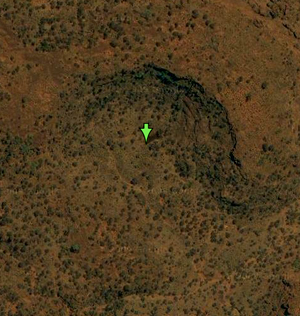
© Google MapsResearchers are using Aboriginal dreaming stories and Google Maps to find new meteorite impact craters.
An Australian Aboriginal 'Dreaming' story has helped experts uncover a meteorite impact crater in the outback of the Northern Territory.
Duane Hamacher, an astrophysicist studying Aboriginal astronomy at Sydney's Macquarie University, used Google Maps to search for the signs of impact craters in areas related to Aboriginal stories of stars or stones falling from the sky.
One story, from the folklore of the Arrernte people, is about a star falling to Earth at a site called Puka. This led to a search on Google Maps of Palm Valley, about 130 km southwest of Alice Springs. Here Hamacher discovered what looked like a crater, which he confirmed with surveys in the field in September 2009.
Cosmic impactThe crater is 280 m in diameter and about 30 m deep. Magnetic and gravitational data collected from the site show the crater is bowl-shaped below the surface and was likely caused by a meteorite a few metres in diameter.
"There is no other way to explain this than as a cosmic impact," said Hamacher. "It couldn't have been erosion and there is no volcanic activity in the area."




